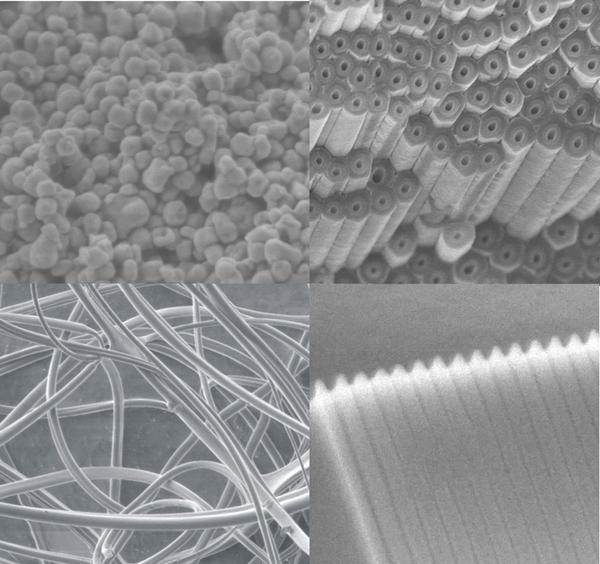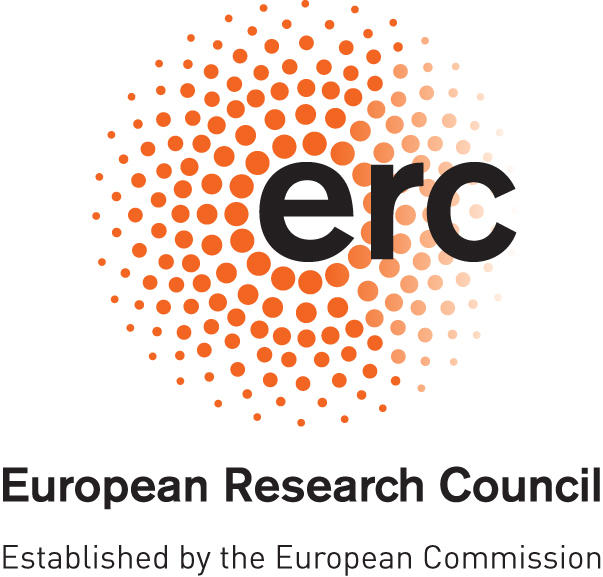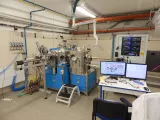1. Large research infrastructure CEMNAT
 Provider: Ministry of Education, Youth and Sports of the Czech Republic, project LM2023037
Provider: Ministry of Education, Youth and Sports of the Czech Republic, project LM2023037
Principal investigator: prof. Ing. Tomáš Wágner, DrSc.
This project provides funds from public resources in the total amount of 58 343 000 CZK for years 2023-2026. These funds will cover mainly personnel costs and operational costs of R&D employees carrying out their activities within all 4 principal scientific directions of CEMNAT in the OPEN-ACCESS regime.
CEMNAT focuses its research activities on the synthesis of high performance materials, their characterization and exploitation in applications, including materials for the needs of cooperating research institutions and companies. This in particular covers to amorphous or crystalline inorganic materials - metal oxides and chalcogenides, that are key materials for various fields (non-silicon sensors, solar cells, memories, batterries, optoelectronics, catalysis).
All these materials belong to category of high-tech materials for so-called emerging technologies. With respect on the nanotechnological focus of CEMNAT, these materials are investigated in various forms that have dimensions on nanoscale. Among these forms belong nanoparticles, nanotubes, nanofibers, thin layers. See illustrative images of these structures below.
Infrastructure and know-how of CEMNAT is available for research organizations and companies from the Czech Republic as well as from abroad.
2. Engineering of bipolar electrochemical technology for the next generation of TiO2 nanotube Layers
Provider: Czech Science Foundation, project 23-06793S
Principal Investigator: Dr. Lina Marcela Sepulveda
The project aims to engineer bipolar electrochemical technology for the synthesis of anodic 1D TiO2 nanotube layers on small/3D Ti objects (allowing to process previously non-anodizable substrates) and the modification of nanotube layers with secondary materials for photo- and electrocatalysis
3. Tunnig of optical properties of amorphous, thermally and laser-crystallized chalcogenide-based phase change materials for nanophotonic applications
Provider: Czech Science Foundation, project 23-07574S
Principal Investigator: Ing. Miloš Krbal, Ph.D.
The aim of this project is to elucidate the differences in the optical properties of as-deposited, annealed, laser reamorphized and laser-crystallized phase change thin films to optimize designs for photonics. Attention will be paid to the effect on chemical composition, structure and laser fluence.
4. Two-dimensional transition metal-based phosphides by Atomic Layer Deposition
Provider: Czech Science Foundation, project 23-07071S
Principal Investigator: Dr. Raul Zazpe
The aim of this projects is to boost the synthesis of 2-dimensional transition metal phosphides (TMPs) via atomic layer deposition (ALD) by identifying and synthesizing phosphorous compounds as suitable ALD precursors. Resulting TMPs (e.g. CoP) will be characterized and their potential in energy related applications assessed.
5. International Experiences for Students – aimed on the education of American students in materials research of non-crystalline materials in the form of medium-term internships within the years 2022 to 2024
Provider: National Science Foundation (USA)
Principal Investigator: Prof. Ing. Miroslav Vlček, CSc.
PROJECTS REALIZED AT OTHER RESEARCH WORKPLACES , WHERE CORE CEMNAT EMPLOYEES SIGNIFICANTLY CONTRIBUTE
1. Single-Atom-based 2D-Photocatalysts
Provider: Czech Science Foundation, project 23-08019X
UPCE co-investigator: Dr.-Ing. Jan Macák
The aim of this project is to exploit the interplay of single atom (SA) co-catalysts and photocatalytic surfaces on highly defined scalable semiconductor thin films, to elucidate fundamental aspects in SA configurations as co-catalysts, to establish most effective scaffold for photocatalyticphotoelectrochemical reactions.
2. Transverse transport phenomena in hexagonal alloys with collinear and canted antiferromagnetic arrangement
Provider: Czech Science Foundation, project 25-17490S,
Physical Institute of the Czech Academy of Sciences: principal investigator Dr. Kyohoon Ahn
UPCE co-principal investigator: Prof. Čestmír Drašar
3. Ministry of Education, Youth and Sports of the Czech Republic
Innovative materials with high added value suitable for applications
(CZ.02.01.01/00/23_021/0008593),
Principal Investigator: prof. Ing. David Veselý, Ph.D. in cooperation with SYNPO a.s. (prof. Vlček, Dr. Šlang)
Participation of CEMNAT employees on runnnig projects
Czech Science Foundation
- 23-06548S prof. Ing. Roman Jambor, Ph.D. Superhydrophobic materials based on heteroboroxines (Dr. Zmrhalová)
- 23-06562S Mgr. Jan Hynek, Ph.D. Optimization of proton conductivity in zirconium-based metalloorganic networks using peripheral substitution of porphyrin ligands (Drs. Melánová, Beneš, Kutálek, Plecháček)
- 24-10480S Ing. Jaroslav Barták, Ph.D. Physical properties and thermal behavior of chalcogenide thin films prepared from solution and by thermal evaporation: Cheap materials for IR optics (Drs. Jančálek, Kurka)
- 25-15635S, Ing. Petr Knotek, Ph.D., Photoinduced phenomena in infrared-transmissive glasses (Smolík, Kutálek
- 25-17110S, Ing. Roman Svoboda, Ph.D., Phase transformations in ultrathin chalcogenide layers: From in-situ calorimetric measurements to advanced modeling of their kinetics (Drs. Krbal, Durčíková, Ing. Přikryl).
Technology Agency of the Czech Republic
- FW10010224 - Research and development of innovative technology for processing and reuse of tungsten waste (Prof. Pouzar)
- SS07020305 - Use of microalgae to reduce the amount of antibiotics, resistant bacteria and resistance genes in digestate from agricultural biogas plants (Prof. Pouzar)
1. Synthesis of large area TiO2 nanotube layers for effective photocatalytic degradation of pollutants in gas phase and viruses
Provider: Czech Science Foundation, project 21-27243S
Principal investigator: Dr. - Ing. Jan Macák
2. High sensitive sensors and low density materials based on polymeric nanocomposites (NANOMAT)
Provider: Ministry of Education, Youth and Sports of the Czech Republic
Principal investigator: Prof. Ing. Miroslav Vlček, CSc.
The project deals with the development of innovative active and passive materials, ready for practical applications: a) polymer nanocomposite detectors, namely composite stress-strain detectors and scintillators for high energetic conversion of neutron and gamma radiation; b) new materials with low density based on polymer nanocomposite materials, namely nanostructured polymer aerogels with low density for space applications and nanostructured polymer foams with low thermal conductivity for insulation purposes. Developed sensors, foams and aerogels will also find applications in other industry sectors due to their unique properties (automotive, aerospace, defensive, healthcare,….), where extraordinary properties are more important than price of material.
3. Study of chemical and electrochemical processes influencing growth of self-organized TiO2 nanotubes in solutions
Provider: Czech Science Foundation
Principal investigator: Dr. Jan Macák
Details:
4. Technology for advanced nanostructured SiO2 fibers
Provider: Technology Agency of the Czech Republic
Principal investigator: Dr. Jan Macák
Details:
5. Fabrication and characterization of micro- and nanostructures in high refractive index glasses
Provider: Czech Science Foundation, project 16-13876S
Principal investigator: prof. Dr. Miroslav Vlcek
Details:
6. Large Infrastructure Center of Materials and Nanotechnologies (CEMNAT)
Provider: Ministry of Education, Youth and Sports of the Czech Republic, project LM2015082
Principal investigator: prof. Dr. Miroslav Vlcek
Details:
This project provides funds from public resources in the total amount of 29 515 ths CZK for years 2016-2019. These funds will cover mainly personnel costs and operational costs of R&D employees carrying out their activities within all 4 principal scientific directions of CEMNAT.
CEMNAT focuses its research activities on the synthesis of high performance materials, their characterization and exploitation in applications, including materials for the needs of cooperating research institutions and companies. This in particular covers to amorphous or crystalline inorganic materials - metal oxides and chalcogenides, that are key materials for various fields (non-silicon sensors, solar cells, memories, batterries, optoelectronics, catalysis).
All these materials belong to category of high-tech materials for so-called emerging technologies. With respect on the nanotechnological focus of CEMNAT, these materials are investigated in various forms that have dimensions on nanoscale. Among these forms belong nanoparticles, nanotubes, nanofibers, thin layers. See illustrative images of these structures below.
Infrastructure and know-how of CEMNAT is available for research organizations and companies from the Czech Republic as well as from abroad.
More about CEMNAT utilization can be found here.
7. Towards New Generation of Solid-State Photovoltaic Cell: Harvesting Nanotubular Titania and Hybrid Chromophores
Provider: European Research Council, Starting Grant
Principal investigator: Dr. Jan Macák
Details:
Within this project, a close cooperation with the group of Assoc. Prof. Filip Bures is carried on. See Filip´s webpage.


8. Modernization and upgrade of CEMNAT infrastructure
Provider: Ministry of Education, Youth and Sports of the Czech Republic
(nr. CZ.02.1.01/0.0/0.0/16_013/0001829)
Principal investigator: prof. Ing. Miroslav Vlček, CSc.
Details:
The main goal of the project is to upgrade instrumentally and technically the equipment of Center of Materials and infrastructure (which is a one of the institutions on the Roadmap of large research infrastructures if CZE at least till 2020. CEMNAT research team focuses on nano- and microstructures of chalcogenide and oxide materials. For an effective research activity with utilization of already installed instruments (e.g. ALD), CEMNAT researchers need complementary material-analytical techniques (XPS, XRD, SEM). In accordance with the CEMNAT development plan, it also needs new instruments for synthesis of 1D materials (nanofibers) and 2D materials (thin functional layers). However, these instruments are missing in CEMNAT. The project will endorse effective utilization of CEMNAT research infrastructure and will allow increase of the competence and possibilities of researchers in direction to needs all user target groups (internal and external researchers, students, companies).
Following instruments will be purchased from the project budget:
- X-ray photoelectron spectroscope (XPS)
- X-ray diffractometer (XRD)
- Modernization of dual-beam FIB-SEM microscope
- Device for fiber synthesis
- Optical sources- lasers

9. Polymeric fiber materials for capture and killing of viruses and a methodology for the determination of antiviral properties of the fiber materials
Provider: Technology Agency of the Czech Republic, program Gama 2, call COVID-19
Principal investigator: Center for technology transfer, Univerzity of Pardubice, investigator for CEMNAT: Dr.- Ing. Jan Macák
10. Amorphous to crystal (3D2D) transition in van der Waals bonded chalcogenide materials
Provider: Czech Science Foundation, project 19-17997S
Principal investigator: Ing. Miloš Krbal, Ph.D.
11. Engineering of glass formation and photoinduced property modification of hybrid amorphous chalcogenides via controlled content of lone-pair electrons
Provider: Czech Science Foundation, international project, 20-23392J
Principal investigator: Ing. Miloš Krbal, Ph.D.
12. Selenide-based 2D nanomaterials by Atomic Layer Deposition with exciting properties
Provider: Czech Science Foundation, project 18-03881S
Principal investigator: Assoc. Prof. Filip Bureš, Ph.D.
CEMNAT co-investigator: Dr.-Ing. Jan Macák
13. Strengthening interdisciplinary cooperation in nanomaterials research and in studying their effects on living organisms (NANOBIO)
Provider: Ministry of Education, Youth and Sports of the Czech Republic (CZ.02.1.01/0.0/0.0/17_048/0007421)
Principal investigator: Prof. RNDr. Zuzana Bílková, Ph.D.
Principal investigator for CEMNAT: Dr.-Ing. Jan Macák
The aim of the project is to create a team of experts in complementary scientific disciplines (material engineers, chemists - analysts, biologists, geneticists, immunologists, toxicologists, histologists) and to develop modern infrastructure for: 1) development and characterization of engineered nanomaterials (ENMs), 2) their surface modification and biofunctionalization, 3) testing the impact of conventional and newly developed nanomaterials (ENM) on the organisms. In cooperation with all biomedical sites, a functional panel of tests will be developed for this purpose to determine the level of toxicity / biocompatibility of NM at the level of cells, tissues and whole organisms. By validating these methods and by expertly evaluating the obtained results, we want to provide the manufacturers and users of ENMs in the Hradec-Pardubice agglomeration with professional and infrastructural backgrounds for NM characterization. Our primary focus will be on ENMs usable in biomedicine (such as in vivo diagnostics, therapy, vaccination) and in biotechnological processes (e.g. carriers for isolation and purification of bioactive substances, and manufacture of reagents for in vitro diagnostics).
14. Large Infrastructure Center for Materials and Nanotechnology (CEMNAT)
Provider: Ministry of Education, Youth and Sports of the Czech Republic, project LM2018103
Principal investigator: prof. Ing. Miroslav Vlček, CSc.
Details:
This is support from public sources in the total amount of 58,153 thousand.CZK for the years 2020-2022, which were used mainly to cover the salary and operating costs of R&D workers implementing activities in all 4 research areas of the center. The center's research activities focused on the preparation of materials with high added value, the study of their properties and use, including for the needs of cooperating research organizations and businesses. This applies in particular to highly pure amorphous or crystalline inorganic materials – metal oxides and chalcogenides, which are key to various scientific fields (non-silicon sensors, solar cells, memories, batteries, optoelectronics, catalysis). All these materials belong to the category of high-tech materials for so-called emerging technologies. In keeping with the center's "nanotechnology" focus, the above materials are studied in forms that have nanoscale dimensions. These forms mainly include nanoparticles, nanotubes, nanofibers and thin layers.

